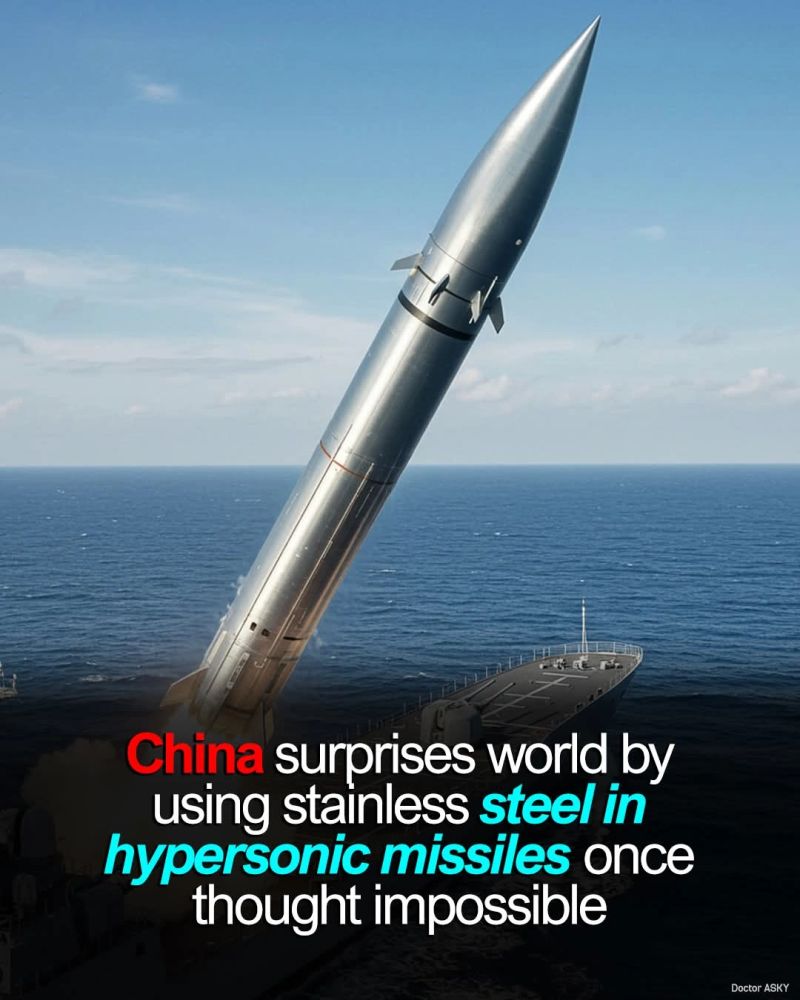
China’s breakthrough in using steel for hypersonic missiles (≥Mach 5) overcomes traditional material limitations through innovative engineering. Here’s a detailed analysis of the technology and its implications:
🔧 1. Core Innovation: Material Substitution with Thermal Protection
- Steel Selection: Chinese researchers use high-strength stainless steel for critical components like nose cones, replacing expensive tungsten alloys (melting point: 3,422°C). Steel melts at 1,200°C—far lower than the 2,500–3,000°C temperatures generated during hypersonic flight.
- Multi-Layer Thermal Protection System (TPS):
- Outer Shield: Ultra-high-temperature ceramics withstand initial aerodynamic heating.
- Insulation Layer: Aerogel (5mm thick) beneath the ceramics provides extreme thermal resistance, reducing heat transfer to the steel structure.
- Result: This TPS maintains internal temperatures below 300°C during Mach 8 flight, preserving structural integrity and preventing warhead detonation.
💰 2. Cost and Strategic Advantages
- Economic Efficiency: Stainless steel costs 10–20× less than titanium or tungsten alloys. For example, U.S. hypersonic missiles using tungsten cost ~$41 million per unit; China’s steel-based design drastically reduces this.
- Mass Production: Steel’s abundance simplifies manufacturing, eliminating specialized facilities needed for composites or rare metals. This enables rapid scaling of missile arsenals.
- Resource Strategy: China controls 85% of global tungsten supply. Using steel preserves tungsten for other critical applications and reduces export dependencies.
⚙️ 3. Performance and Applications
- Speed and Range: Validated for speeds up to Mach 8 (~9,800 km/h) in anti-ship missiles (e.g., YJ-21). The thermal solution also supports “skip-glide” trajectories, extending range by 33%.
- Operational Systems: Steel components are integrated into China’s DF-17 (hypersonic glide vehicle) and DF-ZF missiles, enhancing their cost-effectiveness for mass deployment.
- Ancillary Tech: Coupled with “black barrier” communication breakthroughs, enabling real-time maneuvering and targeting during plasma-blackout phases.
🌐 4. Global Arms Race Implications
- Proliferation Risk: Lower costs could enable exports to allied nations, spreading hypersonic capabilities.
- Deterrence Shift: Disrupts U.S./Russian reliance on expensive materials, potentially tilting the strategic balance. NATO analysts note this “rewrites hypersonic rules”.
- Detection Challenges: Steel may alter radar signatures unpredictably, complicating missile defense systems.
⚠️ 5. Limitations and Future Directions
- Durability Concerns: Long-term performance under repeated hypersonic stress remains unverified.
- Beyond Military: TPS innovations may benefit reusable spaceplanes and high-efficiency power plants.
- Ongoing R&D: Focus includes enhancing steel durability and expanding applications to drones and space vehicles.
💎 Key Material Comparison
Table: Hypersonic Missile Materials vs. Performance Trade-offs
| Material | Melting Point | Cost Factor | Key Advantage | Primary Challenge |
|---|---|---|---|---|
| Tungsten Alloy | 3,422°C | High ($$$$$) | Extreme heat resistance | Scarcity, weight, high cost |
| Titanium Alloy | ~1,670°C | High ($$$) | Strength-to-weight ratio | Complex manufacturing |
| Chinese Steel | 1,200°C | Low ($) | Abundance, 10-20x cheaper | Requires advanced thermal protection |
Conclusion
China’s steel-based hypersonic missiles exemplify pragmatic innovation—turning a “weak” material into a strategic asset via thermal management. This approach prioritizes cost-effective scalability over exotic materials, potentially democratizing hypersonic capabilities while challenging global defense norms. However, real-world durability and counter-detection efficacy require further validation. The technology underscores China’s focus on asymmetric advantages in next-generation warfare.
Leave a Reply